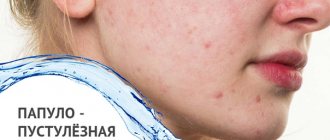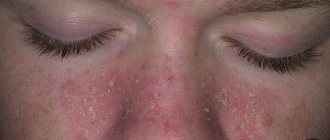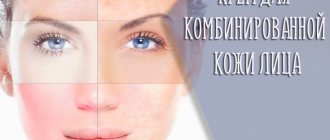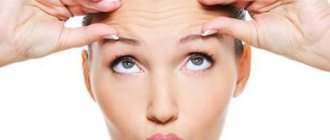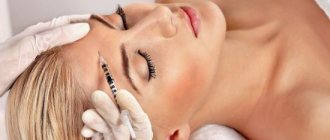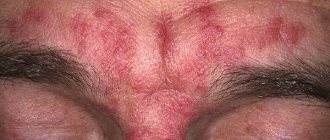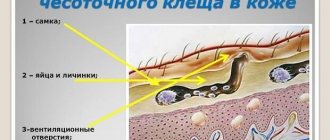To treat skin mites, dermatologists prescribe different types of medications. Spregal aerosol for demodicosis is one of them and is approved by specialists in the field of skin diseases. The components that are part of this spray help remove Demodex from the epidermis. This drug is widely used by the population, because the effect is noticeable after the first time.
Contraindications
When using Metrogyl for acne, it is worth considering that it has some contraindications, but there are not so many of them. You should not use the gel if you have the following conditions:
- If there is individual intolerance to the constituent components, namely metronidazole;
- Not recommended for use in the first trimester of pregnancy;
- Contraindicated in case of impaired functioning of the liver and kidneys.
In general, the product combines well with other antibiotics. However, to avoid overdose symptoms, Amoxicillin should not be used internally.
Description
Before you start using Metrogyl acne gel, you should find out what this product is.
This drug is manufactured in India and is known to all pharmacists as “metronidazole”. It is called so because it contains the active substance - metronidazole. It is this component that has a detrimental effect on many anaerobic microorganisms. This substance suppresses growth, the ability to reproduce, and relieves severe inflammatory processes that appear as a result of their increased activity.
In pharmacies this drug is sold in aluminum tubes. The volume of one tube is 30 grams. Despite the fact that the volume of the gel is small, it lasts for a long period. This is due to the fact that it is not applied to the entire surface of the face, but only to the affected areas.
Advantages and disadvantages
The drug Metrogyl gel is an effective remedy that helps get rid of rashes on the surface of the skin, as well as improve the appearance of the facial skin. This remedy has a large number of positive qualities. But at the same time it also has negative sides.
The advantages of this tool include the following criteria:
- low cost;
- availability. This drug can be found in almost any pharmacy, and it is dispensed there without a doctor’s prescription;
- easy application;
- fast absorption;
- has a drying effect on the skin;
- after using the gel, the skin becomes matte and elastic;
- has a transparent and invisible structure;
- no need to rinse;
- has a healing effect;
- eliminates skin irritation.
However, there are also negative qualities:
- Causes increased dryness of the skin;
- In order to see a positive result, you need to use it regularly;
- After application, avoid exposure to sunlight, as this can cause severe burns;
- Long-term use, which can take from 3 to 9 weeks;
- You should not use Metrogyl gel for demodicosis and urticaria, because it does not eliminate the symptoms of these diseases.
"Spregal": what is it?
This drug is suitable for external use only. Produced in aerosol form, when sprayed it takes on a light yellow color. Refers to a number of acaricidal drugs (used to combat parasites). Prescribed by doctors for demodicosis and scabies. Spregal contains components necessary to eliminate epidermal defects caused by these diseases. The neurotoxic components of the spray interact with skin mites, which reduces their reproduction and promotes death. These components include:
How to use it correctly
How to properly use the gel against acne and acne? This can be found in the instructions, where the entire procedure for using this product is described in detail.
Acne ointment is used according to the following scheme:
- before applying the product, the skin of the face should be rinsed well, cleansed with an alcohol-free product and dried;
- Next, the gel must be applied to the surface of the skin in the form of a thin layer;
- then everything is rubbed in with light massage movements;
- if there are single formations on the surface of the skin, then it is better to apply the product pointwise, without involving healthy skin;
- The drug should be applied twice a day - in the morning and evening;
- The average course of use is two weeks, sometimes it can be longer, it all depends on the condition.
If necessary, the course of treatment can be increased to 2-3 months. However, this drug is not addictive. During the period of use, you should not sunbathe in the sun, get hypothermic and visit baths and saunas.
If all recommendations and rules are followed, a positive effect after treatment will occur within a week after application. The complete disappearance of all pimples and blackheads should be expected within 2 weeks. The main thing is not to forget about contraindications and possible side effects. You can consult your doctor first.
Is it possible to cure demodicosis with Metrogil?
The active substance of Metrogyl is the antiprotozoal and bactericidal drug Metronidazole. The mechanism of its action is to block the synthesis of nucleic acids in protozoa and microbes, leading to their death.
Metrogyl is available in various dosage forms.
- injection solutions, each ml containing 5 mg of metronidazole;
- tablets containing 200 or 400 mg of active substance;
- ointments and gels for local use with 10 mg of metronidazole per 1 ml.
To get rid of iron worms, metrogil is used in the form of ointments. Reviews about their effectiveness vary greatly - from delight at successfully getting rid of the disease, to complete disappointment and the categorical conclusion that Metrogyl is absolutely powerless in the fight against acne.
But the antiseptic and antibacterial properties of metrogil cannot be doubted, so there is no doubt about its benefits in the treatment of inflammatory skin processes that accompany pronounced demodicosis.
We are glad to meet again with regular and new subscribers! The topic of the article today is the drug Metrogyl for demodicosis. Is it possible to use it in the fight against subcutaneous mites, and how to quickly achieve positive results?
Demodicosis is one of the skin diseases. Unlike pimples and comedones, which occur as a result of clogging of pores with sebum and dirt, the appearance of demodicosis is caused by a parasite.
The demodex mite, which can only be seen under high magnification under a microscope, lives on the body of more than half of people and animals. It may not manifest itself in any way for a long time, but under the influence of unfavorable factors (stress, weakened immunity, etc.) it becomes active and begins to declare itself:
- redness of the skin;
- inflammation;
- the appearance of a small rash;
- peeling and unpleasant itching.
conclusions
In the treatment of demodicosis, both as an independent disease and against the background of skin diseases such as rosacea, acne, perioral and seborrheic dermatitis, only an integrated approach and long-term pathogenetic therapy are used against the background of basic skin care.
Despite the fact that the parasitic disease demodicosis is common, the reasons leading to the activation of mites and the development of inflammatory dermatoses have not yet been established. Antiparasitic treatment is not always effective and often leads to the development of resistant forms of the disease.
Demodicosis is a complex problem. It affects not only a person’s health, but also affects his psycho-emotional state.
Contraindications
Obvious contraindications to the use of the drug are:
- individual intolerance to individual components of the drug, and especially metronidazole;
- extensive skin burns;
- the presence of open wounds, ulcers;
- chronic respiratory diseases.
To determine how the body reacts to the drug, it is enough to apply a small amount of gel to one of the areas where the tick is localized. If discomfort occurs (tingling, burning, swelling, etc.), the skin is thoroughly washed with running water, and Metrogyl gel is replaced with another product.
Common side effects include:
- slight swelling occurs at the sites of application to the skin, it takes a long time to go away;
- maintaining hyperemia;
- mild itching;
- hives (small rash);
- a feeling of tightness and slight flaking of the skin.
Doctors say that the manifestation of at least one of the side effects can serve as a good reason for abandoning the gel or replacing it with antibiotics of a similar effect.
Metrogyl gel, by today's standards, continues to be one of the most effective pharmaceutical products in the fight against demodicosis
But remember that it is important to apply it correctly, and then you will definitely defeat the hypodermic mite
See you again on the blog pages!
Metrogyl cream should be used with extreme caution during pregnancy (especially during the first trimester) and lactation, as well as in children. There are no other contraindications other than sensitivity to the components of the drug
Side effects are detected extremely rarely in the form of allergies or mild peeling/irritation of the skin
There are no other contraindications other than sensitivity to the components of the drug. Side effects are detected extremely rarely in the form of allergies or mild peeling/irritation of the skin.
How much does the drug cost? The price of Metrogyl gel reaches 150 rubles. You can find out the cost and buy Metrogyl or its analogues at any pharmacy in your city. The price in Kharkov and other regions of Ukraine varies within 40 hryvnia.
You can leave your reviews about the use of Metrogyl gel for demodicosis and acne under the articles using the comment form.
Instructions for use
To achieve positive results, apply the gel to inflamed areas of the skin twice a day. The product is applied to cleansed skin, from which remaining moisture has been removed, in a thin, even layer, without rinsing off, so it is better to treat the face in the morning and evening.
The gel is quickly absorbed, forming an almost invisible transparent film on the surface, onto which any decorative cosmetics can be applied very easily.
Why should the drug not be applied to wet skin?
In case of severe inflammation, Metrogyl gel is used to apply compresses. To do this, a dense layer of the drug is applied to a gauze bandage, and then attached with pieces of adhesive tape, covering the areas affected by the mite.
Particular care must be taken when applying oil to the upper part of the face. Do not allow the gel to get into the eyes and mucous membrane of the eyelids.
The ointment is applied in a thin layer to clean skin in the morning and evening. The duration of treatment is up to 1 month. Confirmation of the success of the treatment is the absence of the mite and its eggs in biomaterials (skin scrapings or cilia) under microscopy.
The drug "Metrogil" is used in the following situations:
- demodicosis;
- acne vulgaris and rosacea;
- trophic ulcers caused by diabetes mellitus;
- chronic venous insufficiency.
"Metrogil" against demodicosis is not prescribed in the following situations:
- diseases of the circulatory system;
- liver dysfunction;
- children under 12 years of age;
- pregnancy period;
- allergic reactions to individual components that are part of the pharmaceutical product.
In addition to demodex, Metrogyl ointment successfully cures acne, acne, rosacea and seborrheic dermatitis, and poorly healing wounds. It is used not only for the face, but also for all other areas of the skin that need treatment.
The course of treatment with Metrogyl is at least 2-3 months. How is Metrogyl gel used, how to use it? Method of use for acne and demodicosis: the product is applied daily to the affected areas in a thin layer, before which the skin should be thoroughly cleaned and dried. The visible effect of Metrogyl against acne becomes noticeable after three to four weeks. In certain cases, the doctor in the prescribed prescription combines the external drug Metrogyl with Trichopolum tablets.
Causes
In humans, there are 2 types of subcutaneous mites: Demodex follicorum, which lives in the hair follicles and Demodex brevis, which is smaller in size and lives inside the sebaceous glands. Normally, ticks are nothing more than part of a conditionally pathogenic flora, which acquires a pathogenic character only as a result of a demographic boom in parasites.
Metronidazole is easy to find in any pharmacy, most often in tablet form.
Microscopic parasites begin to multiply rapidly, as a rule, against the background of a weakened immune system. Precise factors for the rapid development of demodicosis. Among these reasons are the following:
- severe stress and emotional fatigue;
- a diet with a large share of fatty, smoked, fried and spicy foods;
- use of fatty face creams;
- frequent and sudden changes in temperature and humidity;
- large doses of ultraviolet radiation and excessive tanning;
- disturbances in the hormonal balance of the skin.
When the immune system begins to cope worse with its direct responsibilities, the above factors become the cause of increased sebum production. Excess nutrient material is a good help for the rapid proliferation of subcutaneous mites.
When there are too many parasites, they have to get out of the follicles and glands, which they do by eating passages to the upper layers of the epithelium. This, in turn, is expressed in symptoms of dermatological damage, mainly on the face and in people with loose and soft skin.
Is it possible to cure demodicosis with Metrogil?
When using the most effective acaricidal drugs (chemicals that reduce the number of ticks), treatment often turns out to be ineffective, which is due to the special structure of the external integument of ticks, their larvae and eggs.
The outer shell of the tick is three-layered, especially developed in females. It protects the parasite from external influences. The cuticle has pores - special channels through which water and gas exchange occurs, but large molecules of contact-acting acaricidal agents cannot penetrate. This fact dictates the need for long courses of antiparasitic treatment.
- Increased production of sebum and excessive proliferation of the skin epithelium creates good conditions for the proliferation of iron mites, so daily cleansing of the skin is a mandatory procedure in the treatment of demodicosis on the face and other parts of the body. Foams, gels and lotions are used for this purpose. They remove excess oil and do not dry out the skin. The use of soap is not recommended. The frequency of washing during the treatment of demodicosis should not exceed 1 - 2 times a day. Cleanance gel and medicinal cosmetics from the Exfoliak, Klerasil Ultra, Cetaphil, Sphingogel, Sebium and Zeniak series cleanse the skin well.
- Degrease and disinfect the skin with alcohol solutions with antibiotics (5% chloramphenicol), 2 - 5% solution of salicylic acid, 2% resorcinol, 5 - 10% alcohol solution of camphor.
- Iron mites feed on epidermal cells and sebum, so when treating demodicosis, keratolytic and antiseborrheic agents should be used. The following have keratolytic properties: Benzoyl peroxide (Baziron, OXU-5, OXU-10, Klerasil-ultra), drugs from the retinoid group, Azeloic and Salicylic acids, Resorcinol.
- In case of increased skin dryness, irritation and peeling, the use of moisturizing creams and gels is indicated. The soothing cream “Klin AK”, “Aven for hypersensitive skin”, “Tlerance Extrem” has proven itself well.
- For the purpose of regeneration (restoration) of damaged areas, the use of the restoring cream “Sicalfat” with a zinc-copper complex or “A-Derma Epithelial A.N DUO Restoring Cream” with hyaluronic acid is recommended.
- To prevent the formation of atrophic scars after pustules, it is recommended to use Contractubex gel. Used for 4 weeks.
- Constant humidity and darkness are optimal conditions for the life of iron mites, so it is better to avoid cosmetics during treatment.
- Excessive ultraviolet exposure should be avoided. An increase in the production of vitamin D under the influence of ultraviolet radiation leads to the activation of the synthesis of cathelicidins, which support the inflammatory process.
They treat him according to the principle: “Let’s try...”. Moreover, no treatment regimen guarantees results.
Unfortunately, I did not find any specific anti-demodectic agent.
The most common medical prescriptions are:
- Metronidazole. It does not affect the ticks themselves. Only for pathogenic bacteria, which demodex drags deep into the skin. They complicate the course of the disease.
https://youtube.com/watch?v=h3Jif6iMUYo
It is prescribed both externally (Metrogil gel 1% for external use, Rozamet, Rozeks 2 times a day) and internally in long courses (10-30 days).
I have not found any justification for such a treatment regimen.
In addition to metronidazole, doctors also prescribe drugs based on Ornidazole or Doxycycline, which also do not act on demodex itself.
- Along with antibacterial agents, probiotics and hepatoprotectors are prescribed to increase the chance of the macroorganism surviving after such treatment. And to relieve itching - antihistamines.
- Means designed to destroy ticks. Among the most prescribed are Benzyl benzoate, Spregal (not to irrigate, but to apply on a cotton pad and wipe the skin).
For some reason, no one is bothered by the fact that demodicosis is not included in the indications for these products, and that they are not applied to the face.
They use a lot of other things to smear their face in the fight against demodicosis, including regular sulfur ointment, the veterinary remedy Yam, birch tar, and so on.
- Among cosmetic procedures, doctors most often prescribe cryomassage, i.e. exposure to liquid nitrogen on the skin of the face, which gives a temporary effect, and ozone therapy to restore local immunity.
For ocular demodicosis, antibacterial and antiallergic drops, moisturizing solutions for the eyes, and products from the Blepharogel line are prescribed.
Plus systemic therapy with the same antibacterial drugs.
Treatment
It is hardly possible to get rid of the causative agent of the disease. Even if all Demodex individuals are destroyed, new parasites will soon move from their previous owners into the body of the cured person. The main goal of treatment is to eliminate the excess of parasites in the skin, return their number to normal and eliminate the consequences of the disease.
Metrogyl and Flagyl - gels based on Metronizadol
After the diagnosis is made, the attending physician begins to develop a therapeutic course. As a rule, insecticidal and acaricidal drugs are used with the support of immunomodulators and vitamin complexes. Local treatment is carried out with creams, ointments and lotions with an antiseptic and healing effect.
Metronidazole
In most cases, treatment is carried out with antiprotozoal drugs based on Metronidazole. Medicines can be presented both in the form of injections and in the form of ointments and creams for local treatment of scabs and ulcerative lesions. Treatment of skin with alcohol is, as a rule, not recommended by doctors.
The regimen for taking Metronidazole for demodicosis should be determined by a doctor based on the diagnostic results and the individual physiological characteristics of the patient. The drug is available in the form of tablets, ointments, gels, creams, injection solutions, and even in the form of vaginal suppositories, which, however, is not necessary for demodicosis
When talking about how to take metronidazole for demodicosis, you should proceed from the recommendations received from your doctor. As a rule, taking tablets orally does not last more than 2 weeks, after which the parasite population is noticeably reduced, and new skin lesions stop appearing. However, the elimination of cosmetic defects may take 2-3 months.
It is highly not recommended to skip taking the drug, as parasites can take advantage of the unexpected break and acquire resistance to antibiotics. The same applies to secondary infections that accompany demodicosis. Taking a double dose will not bring the desired result, so it is advisable not to forget about taking it.
Trichopolum is also one of the drugs based on Metronidazole
Metronidazole in tablet form is usually taken 2 hours after meals with plenty of water. Side effects may include slight dizziness, nausea, occasional muscle cramps, tingling and numbness of the skin. Also, during treatment you should not drink alcoholic beverages.
Other drugs
Despite the fact that the use of metronidazole for demodicosis has purely positive reviews, its effectiveness can be increased and specialized for a specific patient. Simply put, there are many drugs that are based on metronidazole in combination with other drugs.
Local skin lesions in the form of scabs and ulcers are usually treated for several weeks or even months by using aversectin, sulfur, benzyl benzoate, ichthyol, zinc or other ointment, which produces an antiseptic effect and has an anti-inflammatory effect.
As a rule, these products do not contain metronidazole, but are an effective aid in therapy, and therefore are often recommended by the attending physician for combined use with tablets and metronidazole creams.
Efficacy of Metronidazole
Metronidazole is a medicine from the group of antibiotics, the action of which is aimed at destroying bacteria in the patient’s body. It is prescribed as part of the comprehensive treatment of people for demodicosis.
The medication must be taken in extremely strict accordance with the recommendations and prescriptions of physicians. Exceeding or reducing the dose of the medicine is strictly prohibited.
This medication has proven to be a highly effective auxiliary component. However, its effectiveness as a separately used remedy for demodicosis is no less high.
In addition to following the recommendations regarding the dosage and time of taking the medication, it is worth considering that while taking this medication, it is mandatory to refrain from drinking alcohol. Pregnant women should also be especially careful.
Brief information about the causative agent of the disease
Demodicosis is caused by the subcutaneous demodex mite. The second name of the parasite is ironworm acne. This is a small (no more than 0.5 mm in length), worm-like parasite with eight legs on the front of the body.
It lives in hair follicles and sebaceous glands - mainly the face, but can also colonize other areas of the body - the back, chest, legs. Feeds on sebum and skin particles.
The spread of the mite to uninfected surfaces is possible both from a person’s hands (for example, after scratching acne on the face) and as a result of the parasite’s independent movement across the skin.
The speed of the iron is small; in 1 hour it can cover no more than 10-15 mm, but this is enough to spread over the entire surface of the body over time. Ticks usually travel at night. During the day, to escape bright light, he prefers to hide deep in the follicles and sebaceous glands.
Demodex is a bisexual creature that reproduces by mating. This happens at the mouth of the follicle or gland. The female moves deeper to lay eggs. After a few days, the eggs hatch into larvae. The entire cycle of transformation of an egg into an adult takes about 2-3 weeks.
It is believed that D. folliculorum and D. brevis are present on the skin of most healthy people, without causing them any harm for the time being. Under favorable conditions, parasites begin to actively reproduce, causing demodicosis.
To become the owner of acne, it is not at all necessary to become infected with a mite from a sick person (although this path is also possible). A weakened immune system or illness of some disease that is a risk factor for demodicosis, for example, viral hepatitis or diabetes mellitus, is sufficient.
Symptoms
Symptoms of demodicosis appear in areas where there are sebaceous glands. This is almost the entire body, except for the feet and palms. Therefore, it is worth highlighting three areas where the disease can manifest itself - the eyelids, the visual apparatus and the body.
The disease causes severe allergies to the eyes, which results in additional symptoms. This condition is called blepharitis. It is caused by a blockage of the meibolium glands. The first signs of demodicosis of the eyelids and eyes are:
- Redness of the eyes and surrounding area.
- The appearance of pain, burning, lacrimation.
- Peeling of the skin around the eyes, which causes a white coating to form on the eyelashes.
- The eyelid becomes thicker, and a dense crust forms on its surface. Periodically it cracks, which leads to the appearance of ulcers.
Another eye disease that can appear as a result of the action of demodex is ophthalmodemodex. It manifests itself as an allergic reaction several weeks after the development of blepharitis or the skin form of the disease. In this case, demodicosis may have the following symptoms:
- The appearance of a large number of blood vessels, causing redness of the eyes.
- The eyes begin to get tired quickly, resulting in constant discomfort.
- It feels like there is a foreign object in the eyes.
- Swelling appears, the eyelids become heavy.
- Dry eyes.
- There is a disruption in the functioning of the visual organ.
Demodicosis is complicated by the fact that it can spread to other parts of the body. When a skin disease occurs, the following signs are observed:
- Appearance of a rash.
- Redness of the skin with possible merging of small red spots into one large one.
- In the area of inflammation, the skin becomes denser. This is easy to determine by palpation.
- The inflamed area often itches. Itching becomes more severe with increasing air temperature and lack of necessary hygienic care.
- Blisters may form on the skin. This happens because the sebaceous gland is clogged with mites, and the sebaceous secretion cannot come out. The gland enlarges, which is why a bubble appears.
- Inflamed skin peels off.
Depending on the area of damage, the necessary treatment is selected.
Metrogyl gel method of application
a thin layer of gel is applied to a previously cleansed affected area of skin 2 times a day (morning and evening) and lightly rubbed. A pronounced clinical effect occurs after 3 weeks of therapy.
Metrogyl gel: contraindications
hypersensitivity to metronidazole, other nitroimidazole derivatives and other components of the drug; I trimester of pregnancy and breastfeeding period.
Side effects
local reactions are possible - hyperemia, dry skin, burning sensation and skin irritation. When applied to the skin in the eye area, lacrimation may occur.
special instructions
Avoid getting the gel in your eyes
When applied to large areas of skin or with prolonged use, there is a possibility of resorption of metronidazole and the development of systemic side effects, so the drug should be prescribed with caution to patients with impaired hematopoietic function. If local reactions occur, the drug should be used less frequently or temporarily discontinued
Metronidazole penetrates well into breast milk, so it is not recommended to use Metrogyl during breastfeeding. After applying the gel, you can use cosmetics. During pregnancy, it is prescribed only if absolutely necessary.
Interactions
with external and intravaginal use of Metrogyl gel, an interaction due to systemic absorption of metronidazole is unlikely. However, when prescribing the drug to persons receiving anticoagulants, it should be remembered that metronidazole may enhance the anticoagulant effect of coumarin and warfarin, which leads to an increase in prothrombin time.
Contraindications and side effects
Metronidazole is a strong antibiotic, so it has a number of restrictions for use; some negative reactions may occur during treatment.
Possible side effects:
- dyspeptic disorders - diarrhea or constipation, nausea, loss of appetite, colic, sometimes severe thirst, exacerbation of pancreatitis, stomatitis;
- disturbances in the functioning of the central nervous system - attacks of dizziness, problems with coordination, depression, irritability, headache, insomnia;
- allergic reactions in the form of rash, redness of the skin, itching;
- disruption of the urination process, sometimes the urine turns red-brown;
- thrombophlebitis.
The video is dedicated to the treatment of tick-borne acne with antimicrobial drugs:
The drug is not prescribed for hypersensitivity, intolerance to the ingredients of the drug in nursing women, patients with a history of epilepsy, leukopenia.
The video provides detailed information about the features of Metronidazole:
The medicine should be taken under constant medical supervision during pregnancy, in the presence of liver and kidney failure.
All side effects of the drug are short-term and reversible.
Metronidazole helps to quickly cope with the manifestations of demodicosis and has a detrimental effect on the causative agents of dermatological pathology. The drug is a strong antibiotic, so before starting treatment you should carefully study the instructions and do not exceed the recommended dosage.
Overdose
To date, no cases of overdose of the described medication have been recorded. If medicine for parasites accidentally gets into the oral cavity, you should contact a medical facility for qualified help. The patient undergoes gastric lavage during the first 60 minutes and is prescribed enterosorbents. Treatment in case of overdose is symptomatic.
Successful treatment of any disease depends on many factors. One of the most important is adequately selected treatment. That is, it is important not just to compare the indications and prescribe the drug. It is very important to take into account the individual characteristics of the patient, the manifestations of the disease, and its features. Demodicosis is a parasitic disease that is very difficult to treat. There is a reasonable opinion about the use of acaricidal drugs. Does a remedy like Spregal help with demodicosis?
